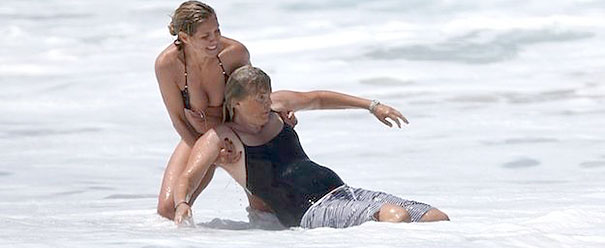
The danger of rip currents was proved over Easter holidays in Oahu, Hawaii. Supermodel Heidi Klum [http://www.latimes.com/entertainment/gossip/la-et-mg-heidi-klum-saves-drowning-son-hawaii-20130401,0,7248685.story] saved her 7-year-old son and two nannies from drowning in a rip current that had swept them out from the beach where they had been enjoying the surf.
As soon as you get in the water, you can feel its current pulling at your body. Many swimmers love to swim with the current and “catch a wave” to body surf or ride a wave in from a surfboard. This same current can also be dangerous, even for those who know how to swim, when conditions converge to turn current into a rip currents. It is important to encourage swimming lessons for children as early as six months from reputable swim instructors like those at Little Otter – where children can take lessons year-round. Knowing how to swim is not always enough to survive the power of the water when rip currents occur. Understanding how rip currents work and how to escape them can be life-saving!
Exactly what are rip currents?
Rip currents are powerful channeled sea currents that occur in oceans, lakes and other large bodies of water. They are formed by strong winds pushing water toward the shore and can move as fast as eight feet per second. Rip currents flow away from the shore – pulling people within their reach out but not down with powerful force. Most rip currents are no more than 100 feet wide and generally subside 50-100 yards from the shore. However, there are times when conditions can allow rip currents emerge closer to the shore. Because they are formed by strong winds, rip currents are often the first indicators of a hurricane’s approach.
Even the strongest swimmer can be overpowered by the strength of a rip current. While avoiding the water during hurricanes and tropical storms is an obvious smart precaution, it is more difficult to tell when conditions are right for rip currents. But there are a few signs that may point to more dangerous swimming conditions and they include:
• Choppy water
• Water that is a different color from other parts of the ocean/lake
• A break in the wave patterns
• A line of foam or debris
These and signs from lifeguards are good indications that rip currents are occurring nearby.
What should you do if you find yourself or see someone else caught in a rip current?
1. Don’t panic. Whether you are the swimmer or the observer, staying calm in a rip current is the most important thing you can do.
2. If you are shallow enough, simply stand up. Or try to lower your legs to try to interrupt the current’s ability to sweep you outward. Rip currents pull away from shore, not under the water. The term undertow is misleading and causes many to think they cannot stand up when being pulled by the ocean’s current.
3. Raise your arms to alert someone you are in need of help. This is also beneficial to someone who may be trying to find the swimmer in distress.
4. Begin swimming parallel to the shore instead of toward it (which is against the current). Continuing to swim toward the shore and against the current risks exhaustion and drowning. Imagine the riptide is like a treadmill. You simply need to swim parallel to the shore until you are out of the riptide’s path and can “step off the treadmill.”
5. Should you become exhausted or are unable to swim for that long, remember floating on your back. This is a skill learned early in swim lessons, along with treading water, and is crucial in times like these. Floating takes little effort and can give you the break you need to restore your stamina.
6. Once you are out of the rip current’s path, you can begin swimming toward the shore. Riptides are not very wide, so you shouldn’t have to swim more than 150 yards to get to safety. But remaining calm will help you remember this in an otherwise stressful, panic-inducing situation.
7. Whatever you do, do not try to swim out to rescue someone who is caught in the rip current. This is one of the easiest ways people can become injured or risks getting caught in the rip current, as well. As an observer, always alert the lifeguards on duty or call 911 to help a swimmer in need.
What other general water precautions should you keep in mind?
Swim with a buddy. Know where lifeguards are. Bring a cell phone or have a record of your temporary address (if vacationing) in your bag. Never swim when “no swimming” flags are posted.
Even for strong swimmers and children who have had swim lessons, there are elements – like rip currents – that can be dangerous.
Rip currents should not diminish your excitement or love for the water. Understanding what dangers like rip currents are all about and how they can be avoided or dealt with, can help you to enjoy swimming in bodies of water where rip currents can occur. Always respect the power of water and learn to enjoy it safely.


Conversations